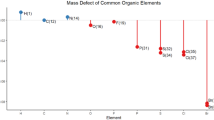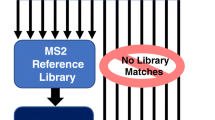Abstract
Non-targeted analysis (NTA) is a rapidly evolving analytical technique with numerous opportunities to improve and expand instrumental and data analysis methods. In this work, NTA was performed on eight synthetic mixtures containing 1264 unique chemical substances from the U.S. Environmental Protection Agency’s Non-Targeted Analysis Collaborative Trial (ENTACT). These mixtures were analyzed by atmospheric pressure chemical ionization (APCI) and electrospray ionization (ESI) using both positive and negative polarities for a total of four modes. Out of the 1264 ENTACT chemical substances, 1116 were detected in at least one ionization mode, 185 chemicals were detected using all four ionization modes, whereas 148 were not detected. Forty-four chemicals were detected only by APCI, and 181 were detected only by ESI. Molecular descriptors and physicochemical properties were used to assess which ionization type was preferred for a given compound. One ToxPrint substructure (naphthalene group) was found to be enriched in compounds only detected using APCI, and eight ToxPrints (e.g., several alcohol moieties) were enriched in compounds only detected using ESI. Examination of physicochemical parameters for ENTACT chemicals suggests that those with higher aqueous solubility preferentially ionized by ESI−. While ESI typically detects a larger number of compounds, APCI offers chromatograms with less background, fewer co-elutions, and additional chemical space coverage, suggesting both should be considered for broader coverage in future NTA research.

Graphical abstract


Similar content being viewed by others
Data availability
The datasets generated during and/or analyzed during the current study are available in the EPA’s ScienceHub and/or the accompanying supporting information.
References
Sobus JR, Wambaugh JF, Isaacs KK, Williams AJ, McEachran AD, Richard AM, et al. Integrating tools for non-targeted analysis research and chemical safety evaluations at the U.S. EPA. J Expo Sci Environ Epidemiol. 2018;28:411–26. https://doi.org/10.1038/s41370-017-0012-y.
Andra SS, Austin C, Patel D, Dolios G, Awawda M, Arora M. Trends in the application of high-resolution mass spectrometry for human biomonitoring: an analytical primer to studying the environmental chemical space of the human exposome. Environ Int. 2017;100:32–61. https://doi.org/10.1016/j.envint.2016.11.026.
Kind T, Fiehn O. Seven Golden rules for heuristic filtering of molecular formulas obtained by accurate mass spectrometry. Bmc Bioinformatics. 2007;8:105. https://doi.org/10.1186/1471-2105-8-105.
Halket JM, Waterman D, Przyborowska AM, Patel RKP, Fraser PD, Bramley PM. Chemical derivatization and mass spectral libraries in metabolic profiling by GC/MS and LC/MS/MS. J Exp Bot. 2004;56(410):219–43. https://doi.org/10.1093/jxb/eri069.
Souverain S, Rudaz S, Veuthey J-L. Matrix effect in LC-ESI-MS and LC-APCI-MS with off-line and on-line extraction procedures. J Chromatogr A. 2004;1058(1):61–6. https://doi.org/10.1016/j.chroma.2004.08.118.
Ismaiel OA, Halquist MS, Elmamly MY, Shalaby A, Karnes HT. Monitoring phospholipids for assessment of ion enhancement and ion suppression in ESI and APCI LC/MS/MS for chlorpheniramine in human plasma and the importance of multiple source matrix effect evaluations. J Chromatogr B. 2008;875(2):333–43.
Cai S-S, Syage JA. Comparison of atmospheric pressure photoionization, atmospheric pressure chemical ionization, and electrospray ionization mass spectrometry for analysis of lipids. Anal Chem. 2006;78(4):1191–9.
Herrera LC, Grossert JS, Ramaley L. Quantitative aspects of and ionization mechanisms in positive-ion atmospheric pressure chemical ionization mass spectrometry. J Am Soc Mass Spectrom. 2008;19(12):1926–41.
Fernández M, Pico Y, Mañes J. Comparison of gas and liquid chromatography coupled to mass spectrometry for the residue analysis of pesticides in organges. Chromatographia. 2001;54(5):302–8. https://doi.org/10.1007/bf02492674.
Zhou SN, Reiner EJ, Marvin C, Helm P, Riddell N, Dorman F, et al. Development of liquid chromatography atmospheric pressure chemical ionization tandem mass spectrometry for analysis of halogenated flame retardants in wastewater. Anal Bioanal Chem. 2010;396(3):1311–20. https://doi.org/10.1007/s00216-009-3279-6.
Gardinali PR, Zhao X. Trace determination of caffeine in surface water samples by liquid chromatography–atmospheric pressure chemical ionization–mass spectrometry (LC–APCI–MS). Environ Int. 2002;28(6):521–8.
Donot F, Cazals G, Gunata Z, Egron D, Malinge J, Strub C, et al. Analysis of neutral lipids from microalgae by HPLC-ELSD and APCI-MS/MS. J Chromatogr B. 2013;942-943:98–106. https://doi.org/10.1016/j.jchromb.2013.10.016.
Rozenberg R, Ruibal-Mendieta NL, Petitjean G, Cani P, Delacroix DL, Delzenne NM, et al. Phytosterol analysis and characterization in spelt (Triticum aestivum ssp. spelta L.) and wheat (T. aestivum L.) lipids by LC/APCI-MS. J Cereal Sci. 2003;38(2):189–97. https://doi.org/10.1016/S0733-5210(03)00022-5.
Ulrich EM, Sobus JR, Grulke CM, Richard AM, Newton SR, Strynar MJ, et al. EPA’s non-targeted analysis collaborative trial (ENTACT): genesis, design, and initial findings. Anal Bioanal Chem. 2019;411(4):853–66.
Sobus JR, Grossman JN, Chao A, Singh R, Williams AJ, Grulke CM, et al. Using prepared mixtures of ToxCast chemicals to evaluate non-targeted analysis (NTA) method performance. Anal Bioanal Chem. 2019;411(4):835–51.
McEachran AD, Mansouri K, Grulke C, Schymanski EL, Ruttkies C, Williams AJ. “MS-Ready” structures for non-targeted high-resolution mass spectrometry screening studies. J Cheminform. 2018;10(1):45.
Yang C, Tarkhov A, Marusczyk J, Bienfait B, Gasteiger J, Kleinoeder T, et al. New publicly available chemical query language, CSRML, to support chemotype representations for application to data mining and modeling. J Chem Inf Model. 2015;55(3):510–28.
Molecular Networks GmbH, Altamira LLC. ChemoTyper - Chemotype Your Molecular Datasets. 2019. https://www.mn-am.com/products/chemotyper. Accessed 9–29-19.
Mansouri K, Grulke CM, Judson RS, Williams AJ. OPERA models for predicting physicochemical properties and environmental fate endpoints. J Cheminformatics. 2018;10(1):10.
Williams AJ, Grulke CM, Edwards J, McEachran AD, Mansouri K, Baker NC, et al. The CompTox Chemistry Dashboard: a community data resource for environmental chemistry. J Cheminformatics. 2017;9(1):61. https://doi.org/10.1186/s13321-017-0247-6.
McKight PE, Najab J. Kruskal-Wallis test. In: The corsini encyclopedia of psychology; 2010. p. 1–1.
Dinno A. Nonparametric pairwise multiple comparisons in independent groups using Dunn’s test. Stata J. 2015;15(1):292–300.
Chusaksri S, Sutthivaiyakit S, Sutthivaiyakit P. Confirmatory determination of organochlorine pesticides in surface waters using LC/APCI/tandem mass spectrometry⋄. Anal Bioanal Chem. 2006;384(5):1236–45. https://doi.org/10.1007/s00216-005-0248-6.
Dougherty RC. Negative chemical ionization mass spectrometry. Anal Chem. 1981;53(4):625–36. https://doi.org/10.1021/ac00227a003.
Haraguchi K, Kato Y, Atobe K, Okada S, Endo T, Matsubara F, et al. Negative APCI-LC/MS/MS method for determination of natural persistent halogenated products in marine biota. Anal Chem. 2008;80(24):9748–55. https://doi.org/10.1021/ac801824f.
Jing R, Fusi S, Chan A, Capozzi S, Kjellerup BV. Distribution of polychlorinated biphenyls in effluent from a large municipal wastewater treatment plant: potential for bioremediation? J Environ Sci. 2019;78:42–52. https://doi.org/10.1016/j.jes.2018.06.007.
Lee S, Song G-J, Kannan K, Moon H-B. Occurrence of PBDEs and other alternative brominated flame retardants in sludge from wastewater treatment plants in Korea. Sci Total Environ. 2014;470:1422–9.
Sánchez-Avila J, Bonet J, Velasco G, Lacorte S. Determination and occurrence of phthalates, alkylphenols, bisphenol A, PBDEs, PCBs and PAHs in an industrial sewage grid discharging to a municipal wastewater treatment plant. Sci Total Environ. 2009;407(13):4157–67.
Wang Y, Zhang Q, Lv J, Li A, Liu H, Li G, et al. Polybrominated diphenyl ethers and organochlorine pesticides in sewage sludge of wastewater treatment plants in China. Chemosphere. 2007;68(9):1683–91.
Thurman E, Ferrer I, Barcelo D. Choosing between atmospheric pressure chemical ionization and electrospray ionization interfaces for the HPLC/MS analysis of pesticides. Anal Chem. 2001;73(22):5441–9.
Marvin CH, Smith RW, Bryant DW, McCarry BE. Analysis of high-molecular-mass polycyclic aromatic hydrocarbons in environmental samples using liquid chromatography–atmospheric pressure chemical ionization mass spectrometry. J Chromatogr A. 1999;863(1):13–24. https://doi.org/10.1016/S0021-9673(99)00955-3.
Titato GM, Lanças FM. Optimization and validation of HPLC-UV-DAD and HPLC-APCI-MS methodologies for the determination of selected PAHs in water samples. J Chromatogr Sci. 2006;44(1):35–40. https://doi.org/10.1093/chromsci/44.1.35.
Mansouri K, Cariello NF, Korotcov A, Tkachenko V, Grulke CM, Sprankle CS, et al. Open-source QSAR models for pKa prediction using multiple machine learning approaches. J Cheminformatics. 2019;11(1):60. https://doi.org/10.1186/s13321-019-0384-1.
Acknowledgments
The authors would like to acknowledge support from the Oak Ridge Institute for Science and Education and Luxembourg National Research Fund for project A18/BM/12341006. Special thanks to Chris Grulke and Antony Williams for their support with ENTACT and related data, Daniel Todd for assistance with the LC/MS analysis, and James McCord for scientific discussions.
Author information
Authors and Affiliations
Corresponding author
Ethics declarations
Conflict of interest
The authors declare that they have no conflict of interest.
Disclaimer
The views expressed in this article are those of the authors and do not necessarily represent the views or policies of the U.S. Environmental Protection Agency.
Additional information
Published in the topical collection Persistent and Mobile Organic Compounds – An Environmental Challenge with guest editors Torsten C. Schmidt, Thomas P. Knepper, and Thorsten Reemtsma.
Publisher’s note
Springer Nature remains neutral with regard to jurisdictional claims in published maps and institutional affiliations.
Rights and permissions
About this article
Cite this article
Singh, R.R., Chao, A., Phillips, K.A. et al. Expanded coverage of non-targeted LC-HRMS using atmospheric pressure chemical ionization: a case study with ENTACT mixtures. Anal Bioanal Chem 412, 4931–4939 (2020). https://doi.org/10.1007/s00216-020-02716-3
Received:
Revised:
Accepted:
Published:
Issue Date:
DOI: https://doi.org/10.1007/s00216-020-02716-3




